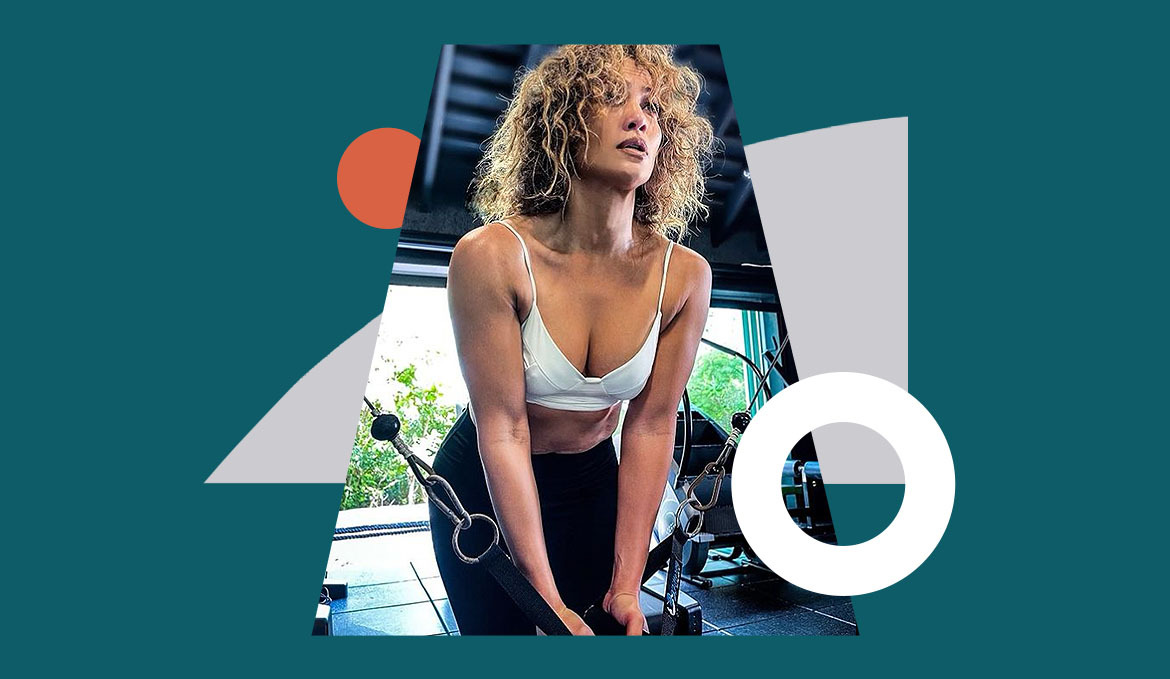- Johanna Sapakie, aerial acrobat, choreographer, dancer, and virtual personal trainer
Last month, I was introduced to Sapakie, who worked with Lopez on the set her movie Hustlers and during her 2020 Super Bowl halftime show, through FlexIt—a fitness app that allows you to virtually work out with and book a personal trainer from home. Sapakie’s background is in acrobatics, dance, and ballet, so, needless to say, our time together was adrenaline-pumping from start to finish.
I booked two 30-minute sessions with her, and hoped to find the secret to how to build strong butt muscles. But to my surprise, the answer to a strong backside wasn’t necessarily in performing endless squats or jumping lunges (though, there’s nothing wrong with that). Instead, every exercise was limited to about six to 10 reps, and we did just two sets of each move. Needless to say, it wasn’t the grueling HIIT experience I was anticipating—it was even better.
Here are the three key takeaways I learned regarding how to strengthen glutes
1. Incorporate moves that target your side glute muscles
The buttocks has three parts: the gluteus maximus, the gluteus medius, and the gluteus minimus. Or as Sapakie likes to say: the top, the middle/back and the side. The key to strengthening the butt is to add moves that focus on all three muscle groups. For example, squats are great for targeting your lower body and the top and bottom parts of your bum, but they don’t really target or strengthen the side. And unfortunately, this an area that most people neglect, she says.
“A lot of times we get stuck in doing an exercise that only works one [type of butt muscle],” she says. “But it’s really important to find exercises that get to all three, so that, for a lack of a better term, you’re getting a more well-rounded booty.”
One of the moves that was *painfully* good for my side glute muscle were kneeling sidekicks. We only did eight reps per leg, but my booty was on fire afterward. See below.
@taylorbell2020Took a class w/JLo’s trainer Johanna Sapakie and this move is killer for your glutes!♬ Girlfriend – Ruger
2. Less is more
Sapakie is a big believer of choosing slow, more controlled and focused exercises that activate your muscles immediately. That usually means finding moves that challenge you from the start. Sure, 50 squats will eventually build your butt muscles and cause your bum to be on fire, but Sapakie says it’s better to stack your workout with exercises that don’t require you to fatigue your butt muscles with a dozen reps to get results. Focus on complex movements like single-leg deadlifts, for example.
3. Add variety to challenge the same muscle
The body can become very efficient at performing the same move over time, so it’s important to constantly challenge your buttocks with new exercises. Again, squats are a good default and help sculpt the bum marvelously, but they’re very “linear,” according to Sapakie. “In our day, we’re twisting, we’re pulling, we’re moving throughout our life, right? So, I like to work glutes in different ways that transition our body through different angles, so it’s more applicable to all the different ways your body moves, as opposed to just linear,” she explains.
Changing exercises in this way not only helps you build strength, but it also allows your butt muscles to work in a different different direction, which means you’ll get a more well-rounded workload.
Oh hi! You look like someone who loves free workouts, discounts for cutting-edge wellness brands, and exclusive Well+Good content. Sign up for Well+, our online community of wellness insiders, and unlock your rewards instantly.
